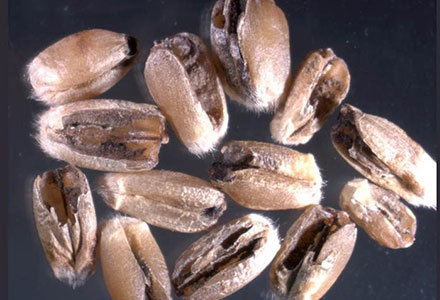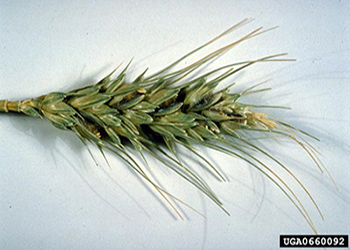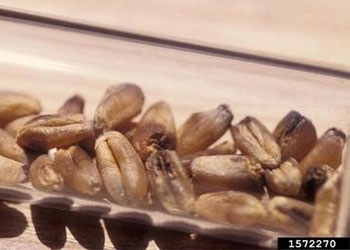PLANT PEST

L.A. Castlebury USDA-ARS SBML, PaDIL.
Karnal bunt
Exotic to Australia
Features: A fungal disease that causes broken hollow (bunted) grain, powdery masses of dark spores, and a strong fishy odour
Where it's from: India originally, but now also Afghanistan, Brazil, India, Iran, Iraq, Mexico, Nepal, Pakistan, South Africa and United States
How it spreads: Spores spread easily on infected wheat seeds, soil, agricultural products, clothing, machinery and on the wind
At risk: Wheat, durum wheat, triticale
Keep it out
Karnal bunt (also called partial bunt) is caused by the fungus Tilletia indica which infects grains at flowering. It reduces grain quality through the production of masses of powdery spores that discolour the grain and grain products. It is recognised by a fishy smell which taints the grain.
The name comes from the city in India, Karnal, where the disease was first identified. Unlike other bunt diseases, only some grains are affected on each wheat ear.
If Karnal bunt made it to Australia, it would have a major economic impact—over 45 international markets would reject our grains and grain prices would plummet.
The fungus would be almost impossible to eradicate once here since its spores can persist in soil for up to four years and they can be carried over long distances by wind.
Importing goods
To keep Karnal bunt out of Australia, never ignore Australia’s strict biosecurity rules.
Import shipments may need to be treated and certified, so before you import, check our Biosecurity Import Conditions system (BICON).
What to look for
Grain that:
- has a blackened and sooty appearance
- gives off a fishy smell
- crushes in hand producing a greasy black powder.


Where to look
Crops that can be affected:
- wheat
- durum wheat
- triticale.
Importers
Infested grain or imported agricultural equipment that is contaminated with infested grain pose the greatest risk of Karnal bunt making it to Australia.
Growers and grain handlers
- Since only a few grains in each wheat head are infected, it is easiest to detect symptoms after the grain has been harvested.
- Check harvested grain regularly.
- Note any unpleasant or fishy smell.
- Look for discoloured grey or black seeds.
What to do
If you think you’ve found Karnal bunt in grain:
- do not disturb the infested produce (this may be as simple as closing the doors on a shipping container or sealing a silo)
- take a photo.
- collect a sample, if possible to do so without disturbing the infested produce.
